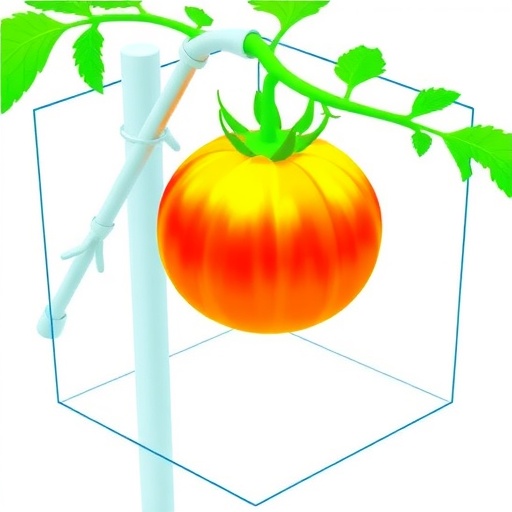In an exciting development poised to revolutionize agricultural monitoring, a research team from the Hebrew University of Jerusalem has unveiled a groundbreaking low-cost technique to estimate total leaf area in dwarf tomato plants through 3D reconstruction from standard video footage. This novel approach leverages advances in computer vision and machine learning to provide an accurate, non-invasive alternative to traditional leaf area measurement techniques. The implications of this research extend far beyond tomatoes, promising enhanced precision agriculture that is more accessible and sustainable worldwide.
Accurate estimation of leaf area is fundamental for assessing plant growth dynamics, photosynthetic efficiency, and water consumption, all critical components for optimizing crop yield and resource management. Historically, obtaining precise leaf area measurements has posed a formidable challenge; conventional methods often necessitate destructive sampling or rely on prohibitively expensive and specialized imaging devices like LiDAR or multispectral cameras. The innovative method introduced by the Hebrew University team sidesteps these obstacles by employing widely available RGB cameras and sophisticated computational algorithms.
At the core of the technique lies the application of structure-from-motion (SfM), an advanced computer vision process that reconstructs three-dimensional geometry from two-dimensional image sequences. Typically used in fields such as remote sensing and archaeological documentation, SfM extracts spatial information by analyzing the motion of features across successive video frames. By capturing the tomato plants from multiple angles and applying SfM algorithms, the researchers generated accurate 3D point clouds that represent the spatial configuration and morphology of the plant foliage without any physical interference.
This 3D reconstruction serves as the foundation for further analysis, where machine learning models are trained to predict total leaf area based on geometric features extracted from the point clouds. Utilizing over 300 video clips of dwarf tomato specimens cultivated under controlled greenhouse conditions, the researchers trained and validated their algorithms. The best-performing model achieved an impressive coefficient of determination (R²) of 0.96, signifying an exceptional correlation between predicted and actual leaf areas. Such a performance surpasses conventional 2D image-based methods and remains robust in scenarios complicated by overlapping leaves or subtle plant motion, challenges that traditionally impair measurement accuracy.
The integration of SfM with machine learning marks a decisive step forward in digital plant phenotyping. It combines the strengths of data-driven predictive modeling with detailed three-dimensional morphological information, enabling more nuanced and precise plant trait analyses. Importantly, this methodology is non-destructive and minimally labor-intensive, thereby preserving plant integrity and facilitating continuous long-term monitoring. The potential to scale this approach beyond laboratory greenhouses into commercial and open-field agricultural environments could transform crop management practices.
Moreover, an outstanding feature of this technology is its crop-agnostic design. Since the method relies exclusively on standard RGB imagery and adaptable machine learning frameworks, it can be generalized to a variety of plant species without costly sensor arrays. This universal applicability is critical for deploying resource-efficient precision agriculture tools, especially in low-income regions where economic constraints hamper access to cutting-edge agricultural technologies.
The research team has emphasized open-source dissemination of their model implementations, inviting the global scientific and agricultural communities to contribute to further refinements and adaptations. Open collaboration is anticipated to accelerate integration with existing crop-monitoring platforms and foster innovations tailored to diverse cropping systems and environmental conditions. Ultimately, this democratization of technology could empower smallholder farmers and large agribusinesses alike to make data-informed decisions, enhancing sustainability and productivity.
The impetus behind this advancement is also ecological. As agriculture faces increasing pressure from climate change and resource limitations, sustainable intensification becomes pivotal. Precise leaf area data informs irrigation scheduling, nutrient management, and pest control measures, underpinning more efficient resource utilization. The low-cost, scalable nature of this method aligns with sustainable development goals by reducing reliance on expensive infrastructure and minimizing environmental footprints.
Dmitrii Usenko, the lead PhD candidate spearheading the study, remarked on the transformative potential of this approach: “By eliminating cost and accessibility barriers, we hope this method will catalyze a shift towards smarter, data-driven farming worldwide.” Under the guidance of Dr. David Helman and collaboration with Dr. Chen Giladi, this research exemplifies the power of interdisciplinary synergy between environmental science, engineering, and artificial intelligence.
The practicalities of deploying such technology are promising. Given that the input data stems from ordinary video footage, existing farm equipment and mobile devices could be harnessed for image capture without significant capital investment. This simplicity facilitates seamless integration into everyday farming routines, delivering real-time or near-real-time analytic feedback to farmers and agronomists.
While the current study focuses on dwarf tomato plants, further investigations are underway to validate and optimize the approach for other crop species with diverse canopy architectures and leaf morphologies. Iterative improvements in machine learning algorithms, including deep neural networks, alongside augmented SfM processing, are expected to enhance sensitivity and versatility even further.
This pioneering work has recently been published in the journal Computers and Electronics in Agriculture, heralding a paradigm shift in phenotypic data acquisition and agricultural monitoring. As the global community grapples with feeding an ever-growing population amid environmental constraints, innovations like this represent critical tools in the endeavor for food security and sustainable agrotechnology.
By seamlessly blending cost-effective imaging, sophisticated 3D reconstruction, and predictive analytics, this new method not only elevates the practice of precision agriculture but also democratizes it. The accessibility it affords empowers a wider range of stakeholders, bridging the technological divide between resource-rich and resource-limited farming contexts.
In conclusion, the Hebrew University team’s integration of structure-from-motion and machine learning opens new horizons in plant phenotyping. This approach exemplifies how computer vision and artificial intelligence can be harnessed to address pressing challenges in agriculture—enhancing measurement accuracy, reducing costs, and fostering sustainable crop management practices worldwide.
Article Title: Using 3D reconstruction from image motion to predict total leaf area in dwarf tomato plants
News Publication Date: 9-Jun-2025
Web References: 10.1016/j.compag.2025.110627
Keywords: Agriculture, Agricultural engineering, Crop domestication, Farming




